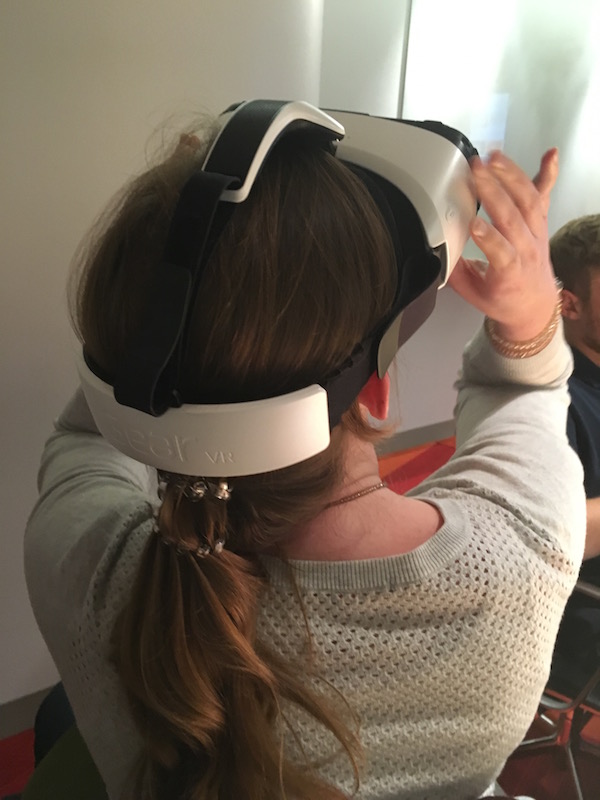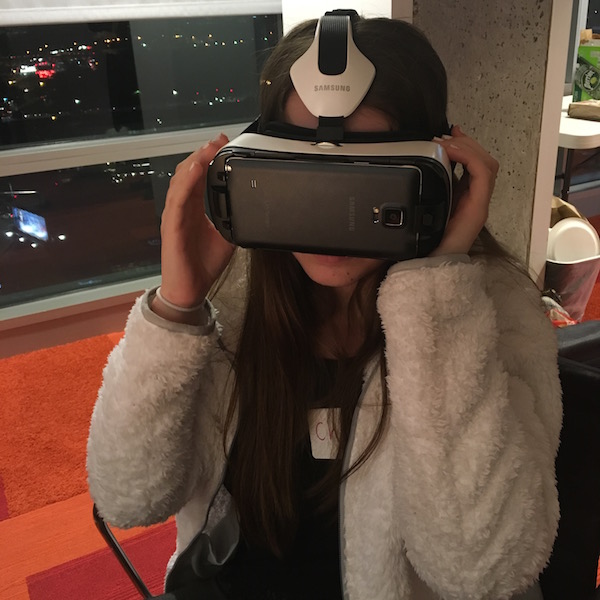I recently brought an enthusiastic Virtual Reality producer to a session with 12 teen agers to explore what the new technology is all about. I had to admit a certain trepidation for this new medium, and the kids were thrilled to investigate. Until you put one of the headsets on yourself, it’s difficult to comprehend the fully immersive nature of a VR experience. (We had the new Samsung headsets that use that company’s Galaxy phones to strap to your forehead). Even though I was standing on level ground in my office, I was afraid to even sway slightly forward, because the goggles I wore projected an image of being on a high stairway looking down. I was afraid I would plummet forward.
It’s that powerful.

My fellow VR newbies — tech savvy teens, no less — were equally amazed by how immediately putting the goggles on plunged them into a strange world. Most had not yet experienced this new technology. But I wager that within six months, they will be bonafide experts about VR and will undoubtedly find uses for it that none of us could anticipate.
A recent Wall Street Journal features a good account the brave new world of VR. Take a moment and click on the “photos” in the article – they’re produced by the VR cameras films 360 degrees and are interactive. Wherever you click your mouse, you can look look up, or left or right, or down and really feel as though you are in the room depicted. It’s not as immersive as when wearing headsets, but you’ll understand a lot about VR by seeing how the camera is able to mimic the eye effectively.
The article neatly demonstrates one of the more obvious uses for VR – viewing real estate. A viewer can understand what an apartment or house looks like through this technology, and you can imagine other non-narrative educational and business applications of VR, including travel, school, and medicine.

Every new technology has pros and cons, and VR presents dilemmas for parents, especially since very little research has been done to study the affects on kids and adolescents. As with many things, business is out ahead of the research and so parents must decide for themselves how they feel about the technology.
VR will have many positive uses — business applications for health, travel are natural, and it has the potential to be used for educational and charitable purposes, especially when it comes to showing us empathy for the plight of those in other parts of the world. I have already been shown a film about a refugee camp in Syria, designed for VR as a first person narrative of a refugee. The film wasn’t great journalism, so was less effective than it could be, but the idea of sharing such far-flung stories for teaching and philanthropy is strong.
VR will most definitely be used by the gaming community – and it’s easy to envision the myriad ways that VR can augment gaming and connect gamers — the Occulus Rift ($600) starts shipping in a few weeks. It will carry a 13+ rating. More on that, soon.
On the negative side, VR will also definitely be used in the porn industry, and parents will need to be cautioned about the pitfalls of an immersive sexual experience. Parents will also need to decide how they feel about a phone being strapped to their children’s foreheads, which is how the most affordable device (the Samsung) is being used. Again, there is not any research on this to date, but it doesn’t feel good as an ongoing way to use VR.
Ultimately, with any new technology, we must wait through the experimentation stage to see the best matches between tech and usage. And, we will have to grow a generation a storytellers to discover how to use this new medium. It’s easy to predict that horror films will triumph in this space, but beyond that obvious application, it remains to be seen who will figure out who can tell a story that best exploits VR.
Here is an article from TechAge Kids in which a mother describes her fascination with the devices and her reservations about what we should be worried about for kids – including physical and emotional dangers of being essentially blindly removed from the real world.

